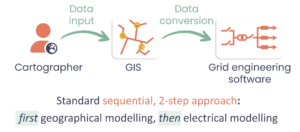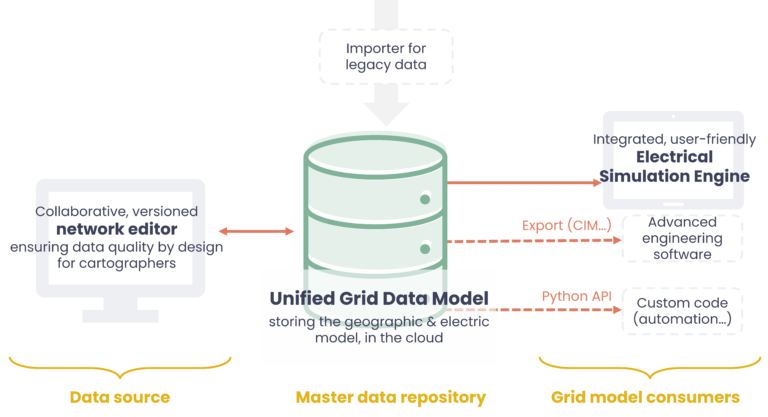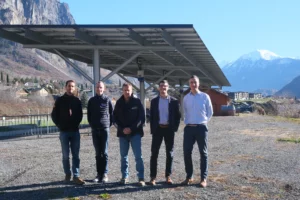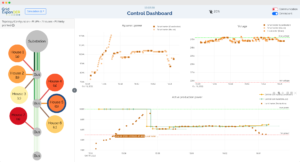Abstract
Grid data management is an essential activity of any power system operator. However, the IT solutions that have been developed so far to handle grid data have high IT complexity. It is thus desirable to investigate how grid data management could be made simpler and more accessible to organisations of all sizes. As a first practical step toward achieving this vision, we advocate the integration of two types of modelling that are currently usually done separately, namely geographical modelling and electrical modelling. The resulting approach, which we refer to as “Unified Grid Modelling“, could help local grid operators benefit from digitalization without significantly increasing the complexity of their IT environment.
Introduction
The need for grid data management
A power grid is a complex infrastructure composed of a multitude of individual assets that are distributed over large areas. As a consequence, grid data must be very carefully managed in order to keep track of crucial information such as the location of assets, their physical characteristics, such as the rated power of a given transformer, the way they are connected to each other (in other words, the topology of the grid), the state of controllable devices, such as the position of a switch or the setting of an off-load tap changer, etc.
Failure to properly manage such information would severely impede the operations and planning of a power grid. As a consequence, Grid Operators and their suppliers have long developed various tools and procedures for managing grid data as efficiently as possible.
Proliferation of IT solutions for Grid Data Management
Over the years, this need has given rise to a multitude of software, databases, data formats, etc, that are dedicated to the management of power grid data.
The first reason for this profusion of Information Technology is that operating a power grid is an intrinsically complex task: as such, it requires many activities, such as short-term and long-term planning, supervision of grid works, maintenance, monitoring and control, outage management, metering and billing, etc. These different activities have been assigned to different departments in the Grid Operator’s organisation, and each department has developed the dedicated tools and procedures that they needed for the specifics of their own tasks and activities.
Another reason for the profusion of Information Technology for Grid Operators is that the development effort has been relatively dispersed: not only have numerous commercial software vendors developed their own software and formats; but also, many Grid Operators have developed custom solutions internally for their specific needs.
Standardisation is still ongoing
In spite of the substantial effort that has been carried out by standardisation committees, in particular with the introduction of the CIM format [[1]], data exchanges between the different software applications used by Grid Operators are, generally speaking, not yet fully standardised.
This observation applies both to software that complement each other and to similar software that substitute for each other. In the first case, data exchanges usually need to occur on a regular basis, sometimes daily or even on-the-fly. In the second case, data conversion is usually a one-time operation that occurs when the software substitution happens.
Consequences for Grid Operators
With so many options to choose from and so many interoperability problems to solve, the space of IT solutions dedicated to power grid data management is currently very complex.
As a consequence, Grid Operators face a dilemma: they either have to support the cost of managing a complex IT infrastructure; or they must renounce some benefits of digitalization, in order to keep their IT infrastructure more manageable. Generally speaking, only large, advanced Grid Operators can afford to opt for the first solution, which means that many other Grid Operators (especially the smaller ones) are deterred from using advanced software tools and thus do not yet fully enjoy the benefits of digitalization.
Either way, there are substantial disadvantages to the current situation:
as far as large, advanced Grid Operators are concerned, it entails large IT costs that could be reduced. Data duplication is an example of an important drawback associated with today’s complex IT ecosystems for grid data management. Indeed, each software product dedicated to a specific business application tends to maintain its own copy of the grid data that it needs to operate. This means that several copies of the grid data are stored, which introduces duplicate work, risks of errors, and the extra burden of checking for consistency across redundant information. The need for Grid Operators to develop and maintain custom interfaces between software applications that are not natively compatible is another similar drawback; etc.
As far as the local Grid Operators are concerned, an example of drawback of today’s situation – and this is the example on which we will focus in the remainder of this paper – is that many such players do not currently use advanced grid planning software, e.g. power flow analysis, N-1 analysis, etc. As a consequence, they do not have access to an accurate assessment of the actual capacity of their grid. This can lead for instance to misdirecting grid investments: the DSO might unknowingly create grid areas with costly excess capacity that does not bring any benefit to grid users, while other grid areas might undergo e.g. voltage constraints that had not been anticipated.
Motivation of our work and specific focus on the case of local DSOs
It is thus highly desirable to simplify and standardise IT solutions dedicated to power grid data management: not only to reduce IT costs for large, advanced Grid Operators; but also to make the benefits of digital grid data management more accessible to smaller, local Grid Operators.
In the remainder of this paper, we will focus on the latter case of local Grid Operators, in particular local Distribution (as opposed to Transmission) Grid Operators. Indeed, distribution grids are now a critical focus for many reasons ranging from the development of Distributed Energy resources (rooftop solar, electric vehicles…) to the roll-out of smart meters, to increased demand for resiliency and power quality. These evolutions are making the operation and planning of distribution grids more complex and are driving the need for better grid data and models that were previously not available. Also, most of the conclusions presented in this paper have been drawn from the observation of local DSOs.
Our objective will be to suggest a software architecture tailored for their needs, that would make it possible for them to benefit from digital grid planning techniques, without substantially increasing the complexity of their tools and IT environment.
Before we turn to the presentation of our suggested approach, we will discuss its relationship with the related work of EPRI.
EPRI’s GMDM approach
In 2017, following a decade of work on the same topic for transmission grids, EPRI started its research on Distribution Grid Model Data Management (GMDM) in order to “address the distribution industry’s challenge of producing and maintaining accurate, accessible grid models” [[2]]. EPRI adopted a collaborative approach gathering two types of stakeholders: utility enterprises on one hand, and vendors on the other hand. The research highlighted the need for centralised grid data management in the form of a “master repository” for grid data, with which all Enterprise Data Sources and Grid Model Consumers would interact through standardised data exchanges.
The expected benefits from the GMDM approach [[3]] are the following.
From the perspective of grid operation and planning: better data quality, consistency and completeness as updates are managed at the single source of truth; reduction of control labour; network studies can be performed faster and with a lower likelihood of errors; etc.
From the IT perspective: reduced cost for data maintenance; reduction of the cost of application upgrades; new requirements for automation can be implemented faster; etc.
Comparison of our approach with EPRI’s GMDM
While the approach that we propose in this paper shares many similarities EPRI’s GMDM, there are also substantial differences.
Firstly, the GMDM approach aims at comprehensiveness: its objective is to capture into the CIM format all the grid information that the Grid Operator could potentially need for any of its business applications. By comparison, we are only focusing on integrating only two specific building blocks of a Grid Operator’s IT infrastructure, namely, Geographical Modelling and Electrical Modelling (these two building blocks are discussed in more detail below), into a new “Unified Grid Modelling” approach.
Secondly, the GMDM approach is collaborative and driven by the need for interoperability between the central grid data repository, and the various peripheral software products that interact with it.
On the technical level, this means that EPRI’s work on GMDM is focused on defining a standard for data exchanges, in the form of contributions to the CIM format. On the contrary, because we are not aiming for interoperability between several applications but for specifying a single new application that will integrate geographical and electrical modelling, we focused on other issues such as data storage, access and processing. The resulting design choices are thus very different: while excellent for interoperability, the CIM format would indeed be impractical to natively store, access and process massive amounts of grid data – as these are tasks the CIM format was not designed for.
On the organisational level, a standardisation effort such as EPRI’s GMDM requires coordination between many stakeholders in order to define a common reference. On the contrary, the “Unified Grid Modelling” approach that we suggest below can be implemented by a single software vendor or Grid Operator. It is thus not a coordination effort but, rather, a software design effort.
A few more differences of secondary importance may be noted, such as the fact that our work emerged from discussions with local DSOs whereas the contributors of the GMDM project tend to be larger organisations; or the fact that, in the context of software development project management, the GMDM approach evokes a V-cycle methodology (where comprehensive specification work has been done first by EPRI’s GMDM research team, and implementation will be done second by the industry) whereas we adopt a more incremental, step-by-step approach.
In conclusion, we view EPRI’s GMDM as a “north star”, that is to say, an ambitious long-term vision that sheds some enthralling light on what could be an “ideal” IT system for Grid Data Management, with which all the business applications of a Grid Operator would be seamlessly integrated; while the contribution of this paper can be seen as a less ambitious version of EPRI’s work, that aims at collecting only one of the low-hanging fruits and that can be practically implemented in the shorter term.
Grid Modelling
We focus on two activities of a Distribution Grid Operators: Geographical Modelling, which is pivotal to operating the grid, and Electrical Modelling, which is becoming increasingly important for a DSO’s engineering team.
Geographical modelling
Simply put, geographical modelling consists in maintaining the DSO’s GIS data. For that purpose, rather than using generic GIS software offering only generic objects and general-purpose geodata processing features, Grid Operators usually rely on business-specific GIS software, or business-specific add-ons to generic GIS software, that have been specifically designed or adapted for their needs.
Such dedicated GIS software natively offers objects such as transformers, lines, substations and cabinets, along with specific data structures (e.g. to store the grid topology) and data processing features (e.g. basic power flow calculations) that operate on these objects.
In essence, this paper suggests going further in this direction, by integrating additional electrical modelling features (described below) into the set of business-specific features of GIS software for Grid Operators.
Electrical modelling
The basic electrical modelling features that are integrated into business-specific GIS for Grid Operators are usually quite limited. Large Grid Operators thus usually also rely on additional software, specifically dedicated to the needs of their electrical engineering teams.
This category of software tends to be “wide-spectrum”, in the sense that it aims at answering all possible simulation needs of an electrical engineer, whether they work for a DSO, a TSO, or even a railway company; whether they are in charge of designing a public power grid or the internal grid of a power plant or a factory; etc. For this reason, that type of electrical engineering software tends to be very open; in other words, it offers a plethora of features that the user can freely combine in any manner (as opposed, for instance, to being firmly guided through a task-oriented software wizard). It is thus expert software, with the advantage of being very powerful, and the drawback of usually being also quite complex to use. This complexity may deter non-expert users, or mislead them into drawing wrong conclusions based on misused computational features or inadequate input data.
Sequential modelling and its limitations
A geographical model and an electrical model are two representations of the same grid, yet they are very different in nature. For instance, geographical accuracy is crucial for some applications, such as making sure that third parties performing civil engineering works will not damage underground electrical cables. On the contrary, electrical engineers tend to prefer simplified geodata which makes the electrical topology appear more clearly, without being cluttered by geographical details. Conversely, the impedance of a line is pivotal to an electrical model, while it is irrelevant to many other applications; etc.
From the practical point of view, these two models are also different simply because, as noted above, they are usually stored separately (with data duplication occurring in the process) by the two software applications that are used for GIS and for electrical engineering, respectively.
This creates the need to define the data flow that will be used to share information and validate consistency between these two different, but related, grid models.
The data flow implemented by a Grid Operator that relies on dedicated electrical engineering software is typically sequential: data is first input into the GIS software by cartographers; then it is somehow transferred to the technical database on which the electrical engineering software operates.

However, because a geographical and an electrical model are so different in nature, we observed that transferring data from one to the other often proves challenging in practice.
The main issue, that our suggested approach aims at solving, is the following: because it has limited electrical engineering capabilities, the GIS software is usually very tolerant to electrical modelling errors. A typical example is that of topology errors, e.g. two subsequent lines being disconnected by mistake in the geodata, and thus wrongly looking like a part of a feeder has been left de-energized. Many other types of such errors are usually found in GIS grid data.
A first negative consequence of this situation is that exporting GIS data to the electrical database becomes a complex operation: in the above example, it requires finding (“guessing”) the correct grid topology. While this operation might be simple when only two lines are concerned, it becomes very challenging in dense areas where gaps are left between many lines that are geographically very close to each other.
A second negative consequence is that the data export operation from the GIS database to the electrical database may simply fail: indeed, not all modelling mistakes can be corrected automatically in a reliable manner. This means that electrical engineers will find gaps in the data when using the electrical engineering software, which will create the need to go back to cartographers and try to analyse why exactly the export operations failed in the first place, etc.
Unified Grid Modelling
Our suggestion is to solve this problem by integrating more electrical engineering features into the grid editor that is used by cartographers.
Fig. 1 below describes the suggested architecture. In this Figure, the central block titled “Unified Grid Data Model” contains – very much in the spirit of EPRI’s GMDM approach – both the geographical model and the electrical model in a single database.

The upper block titled “Importer” is a one-time component that serves to integrate the DSO’s legacy data, with separate geographical and (if any) electrical model, into the new Unified Grid Data Model.
The left block titled “Network editor” offers the usual above-mentioned features for this category of software, plus a pivotal “power-flow aware” network editor that prevents electrical modelling errors and acts as a safeguard for cartographers. This architecture:
ensures grid data quality by design,
produces both the geographical model and the electrical model at once,
and thus removes the need for subsequent sequential electrical modelling based on potentially flawed geodata.
The right block titled “Electrical Simulation Engine” offers the simulation features that are needed by a (local) DSO’s grid planners and engineers, and only these features. The point here is to solve the problem of traditional wide-spectrum electrical engineering software which offers plethoric functionalities, usually well beyond the daily needs of a local DSO, with the drawback of making such software sometimes overly complex for some of its potential users.
As a tentative list, we suggest to include only the following features:
power flow calculations,
load modelling i.e. generating load points for diverse situations (LV or MV studies, peak load or peak generation, N or N-1 situation, current situation or future situations in the context of long term studies, for the specific case of unbalanced LV networks, for various level of statistical risk such as “not exceeding this value more than once every X years”…) based on customer data,
definition of several study contexts (connection of a new customer versus routine check for voltage or current constraints), for which the modelling assumptions will be different (e.g. the voltage limits may be more stringent for a connection study than for a routine check),
N-1 analysis, that is to say the ability to define and simulate a set of fallback MV grid configurations that can be used for post-fault restoration by operating switches.
Basic short-circuit analysis to ensure the proper operation of protection relays and breakers.
Note that other features that are commonly found in wide-spectrum electrical engineering software, such as dynamic simulation (either EMT for “electro-magnetic transient” or RMS for “root mean square”), harmonic analysis, optimal power flow, etc, have deliberately been left aside.
This is the reason for the last component on the bottom right of Fig. 1, titled “Export to Advanced Electrical Engineering Software”, that is to say to the type of expert electrical engineering software described above as “wide-spectrum”. This block will be used whenever advanced calculations are required by an expert user, and only in this case.
With respect to today’s situation, this architecture offers the following main benefits:
firstly, because the “Unified Grid Modelling” approach ensures grid data quality by design, the “Export to Advanced Electrical Engineering Software” component becomes a mere format converter that does not need to perform any complex data processing and will be able to reliably export 100% of the grid data – not just some of it.
Secondly, exporting to expert wide-spectrum electrical engineering software becomes a last resort solution for complex tasks carried out by expert electrical engineers. By contrast, less expert users, and people who are more concerned with grid planning than grid engineering per se, will use the “Electrical Simulation Engine” where they will find only the features they really need for their daily tasks, within a much simpler and less open (i.e. more guided) user interface.
We argue that this architecture would make it possible to reach our objective of bringing the benefits of digital grid planning techniques to local DSOs, without substantially increasing the complexity of their tools and IT infrastructure.
Conclusion and perspectives
In this paper, we have described our vision for a “Unified Grid Modelling” approach that aims at solving a set or related problems that we have repeatedly observed among local Distribution Network Operators, and that result in digital grid planning tools often being underutilised by this category of Grid Operators.
A natural next step is the implementation of a first version of the software components that are depicted in Fig. 1 above; this work is currently ongoing.
Another important perspective is to define how the workflow of the “Unified Grid Modelling” users will be managed: this includes the topic of project management lifecycle (designing a grid change in a “sandbox”, asking for review and validation, committing the change to a future date when the grid works will actually be implemented…); the topic of collaboration (sharing and concurrently accessing grid data through the web, merging parallel modifications, handling conflicting changes…); etc. These important aspects of the design of the “Unified Grid Modelling” approach are left for future work.
References
[[1]] IEC 61970 standard.
[[2]] EPRI, 2017, “Introduction to Grid Model Data Management (GMDM): A Best Practice Approach to Managing Distribution Grid Model Data”, EPRI Technical Brief.
[[3]] EPRI, 2022, “Applying the Grid Model Data Management (GMDM) Information Architecture at the Distribution Utility”, EPRI Technical Brief.
This paper from Sébastien Vallet, Benoît Vinot and Florent Cadoux was presented at the CIRED Conference in Roma in June 2023.




